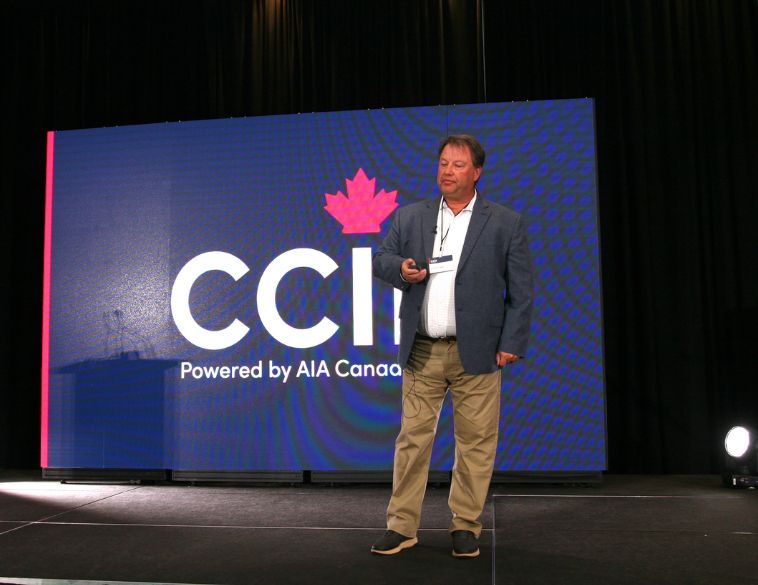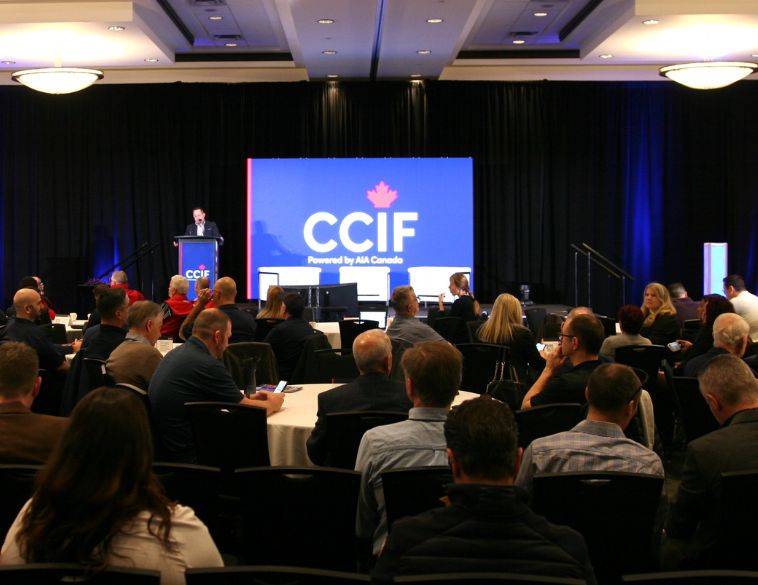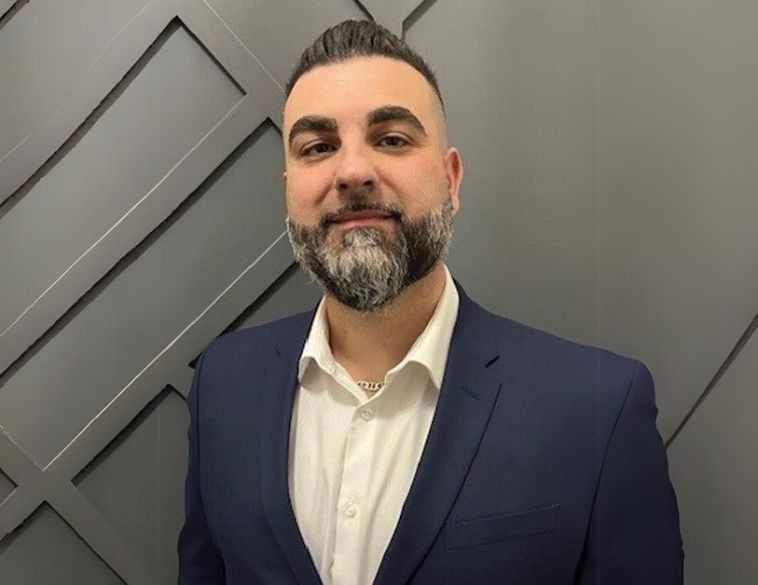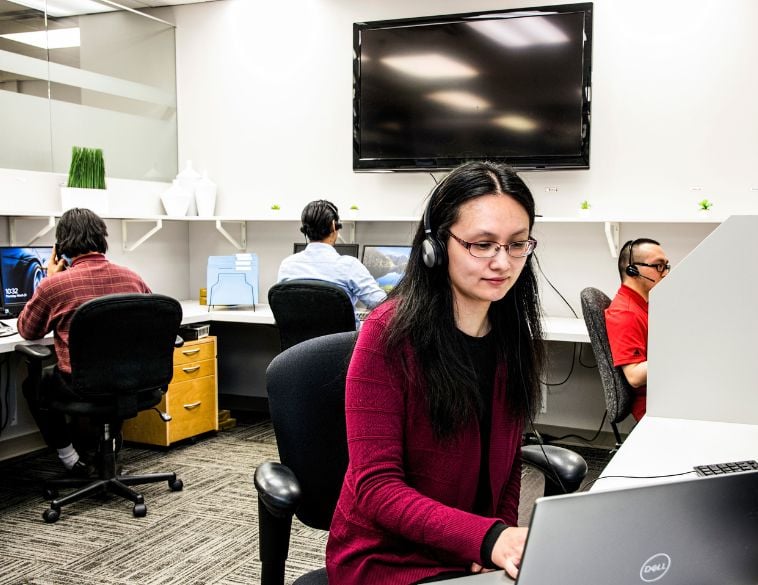CCIF Toronto 2024 officially kicked off to a sold-out crowd and a new venue, well at least new since the COVID-19 pandemic.
The event, with more than 700 registered attendees, returned to the International Centre in Mississauga, Ontario, and, also, witnessed the return of the vendor showcase, in which suppliers and industry partners were able to meet with attendees and showcase their newest products and solutions.
Following an evening cocktail reception at the vendor showcase on February 8, the event proper, began in earnest the following morning.
CCIF Chair Jeff Labanovich welcomed attendees to an auditorium that was, essentially, standing room only. He took the opportunity to recognize the sponsors who make CCIF possible, and also acknowledged the efforts of Enterprise Mobility and Consolidated Collision Services (CCS) that were able to bring 15 students to the event, so they could see first-hand, the type of ideas and conversations that take place here. By doing so, the aim is to encourage more young people to attend these events and engage with the industry, providing not only new blood, but also rewarding career opportunities for those young people who express interest in collision repair.
Additionally, Labanovich took the opportunity to also recognize the efforts of present and past CCIF Steering Committee members, with a special plaque and award photo op on stage during the first networking break of the day.
Labanovic also announced that Sylvain Seguin, President, Fix Network Canada, will be the new incoming CCIF Vice Chair of the Steering Committee. Seguin brings a wealth of experience and industry expertise to the role, given his position as head of a major Canadian collision repair network that has links across the globe.
Attracting and retaining talent
Following Labanovich’s remarks, Marie Artim, Global Vice President, Talent Acquisition, Enterprise Mobility, took to the stage, to discuss How to Attract and Retain Top Talent by Cultivating a Purpose Driven Culture.
Artim noted that the labour market continues to shift, and today, retaining top talent is more challenging than it was in the past. She said that during the COVID-19 pandemic, the rise of remote work and labour shortages, led to employees becoming more picky, which presented challenges for not only finding new recruits but retaining existing high performing and valued team members.
“Most of us in this room are not in a position to offer remote work,” she stated, “but we [still] need people who can be in the office and in the shop—while finding a way to deliver on flexibility.”
She noted that while specific staff need to be on the front-line, engaged with customers and stakeholders, finding customizable solutions for existing employees and new hires can really help. Artim mentioned that presently, we are in a unique period in time, where we have a huge range of people in the workforce, including Baby Boomers, Generation X, Millennials, and Generation Z. In many Western countries, particularly among the G7, the overall workforce is aging, and experienced workers are expected to exceed more than a quarter of the overall labour market.
Artim explained that while finding ways to retain older, experienced workers is essential since they have invaluable knowledge and skills, successfully attracting younger generations is key to longer-term success, particularly as many industries, including collision repair are facing labour and skill shortages. She noted that for Millennials and Gen Z in particular, an organization’s values and social impact are often, a key factor in deciding whether they want to join the company. As a result, she said, organizations need to be laser focused on providing value and purpose, as well as opportunities for people from all walks of life and backgrounds, so they have the chance to shine, as well as providing upskilling and reskilling, so they can successfully navigate through labour shortages. Referencing Enterprise founder Jack Taylor, Artim stated that, “take care of your customers and employees first, and everything else will follow.”

Next up, was a fire chat discussion between CCIF Chair Jeff Labanovich, who also serves as Manager, Business Development and Technical Support, Body Shop Division, for Leader Auto Resources (LAR); alongside Brian Chiu, Category Manager, Collision and Wholesale Parts for Nissan Canada, and Paul Stella, Manager Collision Repair and Refinish, Toyota Canada.
Dealing with counterfeit parts
Entitled Driving Forward: Navigating the Collision Repair Industry Landscape, the discussion tackled a variety of topics, including the rising problem of counterfeit collision parts.
While there are efforts to stem the flow of counterfeit parts, including via organizations such as the Automotive Anti-Counterfeiting Council (A2C2) which includes representatives from several OEMs, including Daimler, Ford Motor Company and Honda, they remain a very significant issue for the industry.
Airbags are a prime example. Counterfeit airbags can fail to deploy, or deploy incorrectly, causing serious or even fatal injuries to vehicle occupants, when if an OEM approved airbag was used those injuries could largely be avoided. Another issue is that counterfeit parts can be exceedingly difficult to track. Brian Chiu noted that in Canada alone, there are at least 21 Nissan vehicles running around sporting counterfeit airbags, the trouble is nobody knows exactly where those vehicles are. He noted that counterfeiting is not just limited to airbags, it can be anything from, sensors, to headlight assemblies, to mirrors, grille assemblies and wheels. And, if a collision centre puts these parts on a vehicle, which often come in packaging and with a look that’s very difficult to distinguish from the genuine OEM product, the OEM is the one on the hook if those parts fail.
Paul Stella concurred that counterfeiters ride on the coattails of OEMs, passing off their products as the genuine article, when in reality, they have performed none of the R&D and testing, meaning that when these parts are subjected to the same rigours as genuine OEM components, they tend to fail, often with potentially dangerous consequences. Stella also noted that OEMs design vehicles as a complete system with all components having a specific function to ensure that system works properly. “Take one component out and that system fails,” said Stella.
So how can OEMs, collision centres and other stakeholders take steps to protect themselves and consumers?

Closed-loop system
Stella noted that for OEMs, the collision parts supply chain is a closed loop system. “It is very difficult for counterfeit parts to come into that loop,” he stated, referring to the journey from OEM, through their official suppliers, to the OEM dealer from which, collision centres purchase parts. That being said, if a collision centre is sourcing parts from a source that is not trusted, that potentially, can open up a whole can of worms, which is why it is so important for collision centres to verify the sources they purchase parts from, and that includes items like clips, as well as sensors.
Other topics of discussion included the need for collision centres to have proper training for their technicians to work on hybrids and EVs, including high voltage systems and proper safety precautions to prevent vehicles from catching fire, such as removing and properly storing the battery packs. Additionally, having access to the proper repair information is essential for returning today’s vehicles back to pre-collision condition.
Another issue currently impacting the industry, is parts that are in short supply or backordered, which impact cycle times and profitability. Paul Stella noted that collision centres can help mitigate this issue by being proactive and pre-booking mechanical service and calibration appointments, along with any other sub-let work. Doing so, will help save time, and ensure the vehicle is repaired more efficiently, resulting in a happier customer and better reputation for the shop, insurer, and by extension, the OEM.
Following the first networking break of the day, Ryan Mandell, Director, Claims, Performance, Auto Physical Damage Solutions at Mitchell, delivered a session entitled Collision Industry Trends.
Debt, price increases and EVs
Mandell explained that the current environment is a challenging one, with multiple factors influencing the automotive industry, and by extension, the collision repair sector. The first is the current debt crisis. The current higher inflation and higher interest rate environment is having a negative impact on consumer spending. In Canada, around 15% of take-home pay is being used to service debt. As a result, and, given the higher interest rates on larger purchases such as housing and cars, Canadians are spending less on them, since they are much harder to finance than they were, even just three years ago.
Over the last several years, scarcity of both new and used vehicles has helped drive prices up, in addition to higher inflation and interest rates. Mandell noted that things are starting to change, with inventory levels rising, creating more stability, particularly in the used vehicle marketplace.
On the collision side, as vehicle values normalize, total losses are starting to rise again, and the average severity rate, both in the U.S. and Canada, continues to climb, with 24 months of consecutive double-digit increases.
Other factors putting pressure on collision repairers include increases in labour rates and the cost of parts. “We’ve seen 17% inflation on aftermarket parts,” said Mandell.
Coupled with increased vehicle complexity and greater use of lighter weight parts, including ultra-high-strength steel and aluminum, which react differently to traditional mild steel, and tend to crack instead of dent or bend, the result is essentially, a perfect storm.
Additionally, with more components being installed on newer vehicles, and pre and post scanning as well as ADAS calibrations required, it costs more and takes longer to repair them.
Mandell also noted that today, only 10% of vehicles being repaired overall, are being properly calibrated in regard to their ADAS systems and even with newer vehicles, that amount is only around 30%.
Mandell stressed the importance of collision centres focusing on ADAS calibrations as an integral part of their business going forward, since they will become more frequent and it won’t be long before more than 60% of all vehicles coming into a collision centre for repairs will need some form of calibration, which must be included in the initial repair plan, making insurers aware of what’s required and why.
Moving onto supply chains, Mandell discussed the conflict in the Red Sea, were Houthi Militants from Yemen and backed by Iran, are targeting cargo ships as they navigate through the region and the Suez Canal. To avoid being attacked many vessels are now sailing around the Cape of Good Hope at the bottom of Africa. The trouble is, these extended journey times are costing the shipping companies more, which is impacting the global supply chain, resulting in parts delays and rising costs. To provide an idea of the significance of the problem, Mandell noted that around 12% of global shipping traffic goes through the Red Sea and as a result, the average cost to move a shipping container has spiked by 35%. He said it was therefore essential that the collision industry factor in the potential disruptions and price increases this could cause, doing it’s best to insulate itself from such external influencing factors.
Speaking of disruptions, another key issue concerns EVs and the increasing adoption rates by consumers which translate to more of them being involved in collisions. Mandell stated that currently, around 3% of all repairable claims concern EVs, and with more cosmetic parts and sensors, plus a greater probability of airbags deploying during a collision, repairers need to be aware of different processes required to fix these vehicles properly as well as safety issues when handling components such as the battery packs and high voltage system components.

Improving profitability
Following the lunch break, Steve Trapp, Business Process Consultant, LEAP (Learning, Experience, Aptitude & Promotion) took to the stage. Trapp, an industry veteran who’s worked for the likes of 3M, Axalta and later ABRA Auto Body in the U.S., before founding his own consulting company, talked about Ten Ways to Improve Profitability. The subject could not have been more timely, given how many collision centres are currently grappling with higher operational costs, labour shortages, capacity issues and growing vehicle complexity.
Trapp discussed the importance of setting an annual strategic plan, as well as “Wildly Important” goals for the shop or business. “Make sure you invest at least one hour regularly to review and understand the income statement,” he said.
Trapp also explained that there are two ways for shops to make more money, either by increasing sales, or reducing costs. In reality, doing so often requires paying attention to both.
He stressed it was critical for shops and collision repair businesses to get their numbers right, and know their gross margin formulas inside and out. Additionally, Trapp said it was important to categorize everything properly. “Make sure you put things in the right bucket, otherwise the accounting will be completely out.”
He also emphasized the importance of shop owners and managers to be part of performance or 20 groups, so they can share ideas and implement policies that will truly benefit their business.
Additionally, Trapp stressed that having a pipeline of talent and a system of developing skilled technicians “a path for Eagles to develop Eaglets,” as it were, was essential for the long-term viability of the business. Furthermore, when training people, it was also important that they get a good handle on every aspect of operations, including administration as well as parts, repair planning, disassembly, and repair and assembly.
Trapp noted that typically, for collision repairers, around 60% of profit comes from labour, so any way that shops can increase their margins will benefit the business long-term. While they can’t always focus on a repair first strategy, given OEM repair requirements and different substrates, where feasible, it should be a priority. He also stressed the importance of dialing in shop processes, so that parts can be ordered pre-painted and there is always a vehicle ready to paint first thing in the morning, ensuring more efficient cycle time and better KPIs. He also noted that where possible, shops should look at owning as opposed to leasing real estate, providing more control over their business and potential future income streams.

Tips for tackling EVs
The final session of the day, came from Joel Dufkis, an ASE Master Technician and I-CAR Instructor. Given that electric vehicles still represent new ground for many repairers, Dufkis delved deep into the topic, talking about a range of topics, including the impact of Alternating Current and Direct Current when working on high voltage systems and the impact it can have on our bodies, the importance of Personal Protective Equipment (PPE), as well as ensuring technicians are armed with the proper tools, including Millohm Meters. He also talked about having a designated EV repair zone in the shop, or if possible, a separate location, so people within the organization know it is a high voltage zone and, requires special safety and repair procedures.
Dufkis stressed the importance of understanding the issue of thermal runaway and even if EVs are waiting to be repaired, it was important that both low voltage and high-voltage systems are disconnected while they are in the yard. “Hybrids and EVs can turn themselves on or off,” he said, “and if the low voltage battery needs to be charged and the vehicle is live, it can use the high voltage battery to do so.” This can potentially create a thermal event, causing the car to ignite and burn not only itself, but everything around it.
He noted that overall, EVs take longer to repair than conventional vehicles, have more ADAS features, and the battery must be properly handled, especially since they are often a structural component of the vehicle. “Pay attention to the high voltage components when doing repairs, use PPE, and follow OEM repair procedures,” said Dufkis.
Besides the sessions on Friday, there were also two workshops on the Thursday, one by Adam Tolowitzki from OEM Connection entitled People, Process and Technology, and another from Jim Bethune, Bethune Consulting Services, on Understanding the Financial Puzzle.
The next CCIF event of 2024 will take place in Montreal, September 19-20. Autosphere will be on the ground, bringing you coverage of the latest trends and ideas within the collision repair industry. We look forward to seeing you there!



